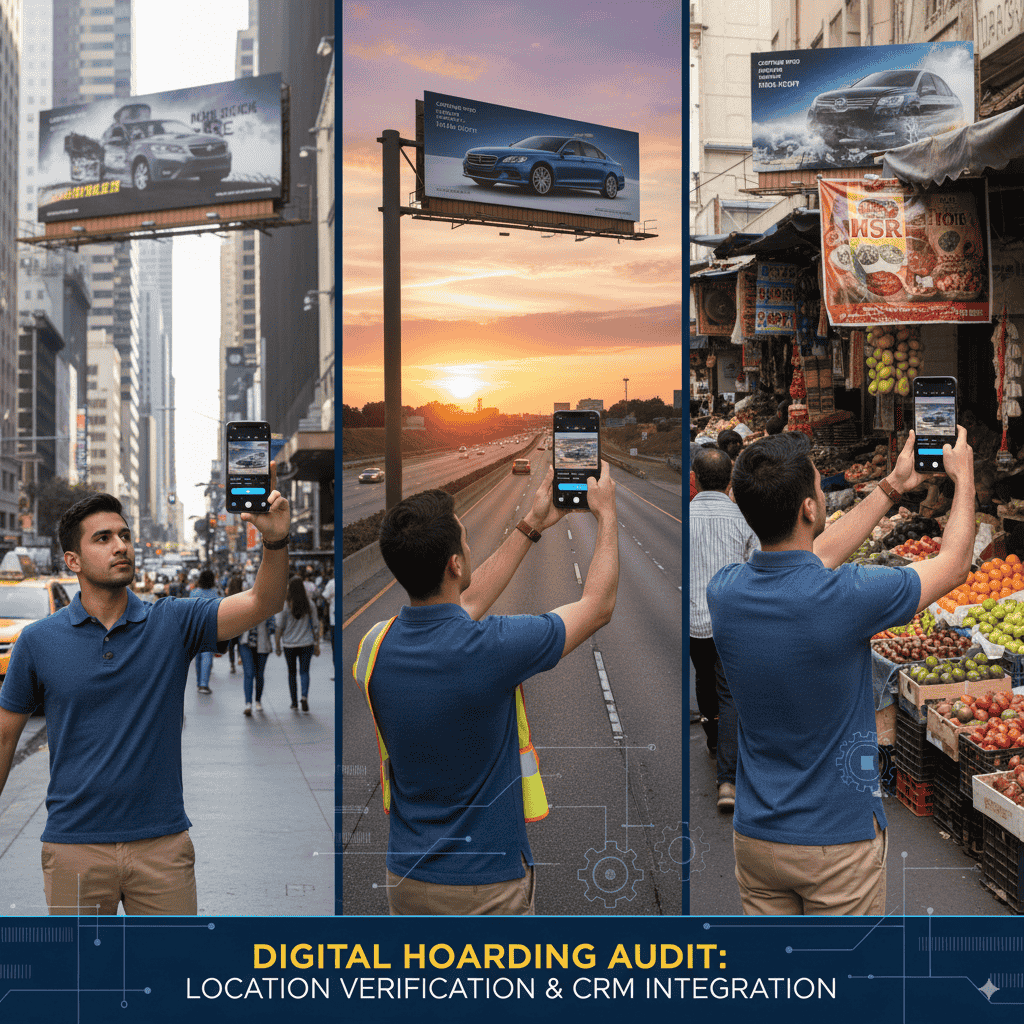Brands across India pour lakhs into hoardings spanning metros, tier-2 junctions, and highway gantries, yet proof of posting still hinges on WhatsApp photos. Edited frames and GPS spoofers slip through the cracks, draining budgets and eroding confidence in outdoor media ROI.
Long Shot binds every proof to the device, time, and coordinates through geo-tagged capture apps and immediate auditor re-checks. This guide shows why photo-only evidence fails, how our integrated workflow operates, and how you can monitor thousands of sites without chasing vendors.
Why Photo Proofs Alone Fail
Traditional proof-of-posting stops at a photo and a timestamp. Without independent validation, three gaps stay open:
- Editing is effortless: Lightweight mobile tools can clean torn vinyl, adjust lighting, or stitch composites in minutes.
- Re-use goes undetected: Old campaign shots resurface with cropped angles and stripped EXIF data, fooling multiple brands at once.
- Location metadata is unreliable: GPS spoofers rewrite coordinates so a Pune install masquerades as Patna until someone spots the mismatch.
Even a 5% fake rate leaks lakhs from monthly spends, making objective, tamper-resistant controls essential.
The Integrated Solution (Technology + Field Verifiers)
Long Shot delivers hoarding verification through a tightly coupled stack: secure capture apps, automatic auditor routing, and a live dashboard that reconciles both streams.
Secure Capture
Vendors shoot inside a 150–250 metre geo-fence. The app blocks gallery uploads and records assignment ID, timestamp, and device hash with each capture, syncing queued shots automatically when coverage returns.
Auditor Re-verification on the Same Lat/Long
As soon as a vendor submits, the nearest auditor receives the job. Their app enforces a 300-metre geo-radius and a six-hour window, comparing live compass heading and sun angle with the vendor shot; missed thresholds escalate to a regional lead.
Evidence Chain of Custody
Every action—from capture to approval—is stamped with user ID, device ID, and coordinates. Log retention is set based on project requirements, and sealed PDFs keep procurement, finance, and legal teams aligned.
How the Workflow Runs
- Client or vendor capture: The vendor scans the hoarding QR in the geo-locked app and submits geo-tagged photos plus install notes.
- Automatic auditor assignment: The nearest auditor receives a push notification with directions and live SLA timers.
- On-site evidence collection: Auditors capture on-site shots to confirm the same hoarding exists at the stated location.
- Dashboard reconciliation: Vendor and auditor evidence appears side-by-side with map pins, time deltas, and status labels.
- Exception handling: Mismatches auto-route to re-visit or escalation queues with reminders until closure.
What Clients See (Dashboard)
The Long Shot dashboard centralises ongoing campaigns and makes verification evidence consumable for CXOs as well as field teams. Key views include:
- Real-time count of hoardings audits completed.
- Day-wise status, including a “today” snapshot.
- Active auditors on field at any moment.
- One-click generation of CSV, PPT or PDF audit reports.
Role-based access ensures brand, agency, and auditor teams see only their queues.
Scale & Coverage in India
Long Shot operates through regional pods covering metros, state capitals, and feeder districts. Our routing engine batches assignments to minimise travel time while meeting SLA windows. Typical coverage includes:
- Monthly verification capacity of 10,000+ hoardings across 28 states and UTs.
- Execution across Tier 1, Tier 2, and Tier 3 cities, with offline-first sync for highway and rural corridors.
Auto-clustering by PIN keeps turnaround predictable, even during festive bursts.
Metrics that Matter
Key KPIs we track include:
- Verification cycle time: Median lag between vendor submit and auditor clearance—typically under 9 hours in metros, 14 in tier-2 cities.
- Budget at risk prevented: Rupee value of sites flagged for rework, giving CFOs a tangible savings number.
Mini Case Study
A consumer electronics brand engaged Long Shot to verify 1,200 hoardings across 180 Indian cities ahead of a festive launch. Within seven days:
- 96.8% of sites were vendor-posted and auditor-verified within SLA.
- 4.2% were flagged for incorrect creative or low-light installs and re-shot within 48 hours.
- 2.1% required vendor rework after duplicate hash checks caught 11 recycled proofs.
- ₹18.6 lakhs in rentals stayed protected until non-compliant sites were rectified.
Leadership reviewed the rollout on a single dashboard, compared auditor notes by state, and greenlit the next burst with confidence.
FAQs
Can we integrate Long Shot data with our existing media planning tools?
Yes. REST APIs and scheduled exports feed platforms like Prisma, Campaign Manager, or your custom sheets.
How quickly can vendors and auditors be onboarded?
Most teams go live in 7–10 working days, supported by vernacular video explainers and in-app nudges.
What if a location has weak GPS or network coverage?
The apps cache coordinates offline, use multi-constellation GPS, and upload evidence with the original timestamp once coverage returns.
Can we customise SLA windows or approval rules?
Absolutely. SLA thresholds, escalation hierarchies, and dual approvals are configurable per campaign or vendor cohort.
Do you cover specialty formats like mall facades or transit media?
Our network includes specialists for high-rise facades, airport media, metro panels, and digital OOH playlists.
How is sensitive data protected?
All evidence is encrypted in transit and at rest, with role-gated access and logged downloads for compliance.
Conclusion & CTA
Outdoor media will always rely on physical installs, but verification can be digital, tamper-proof, and fast. Long Shot unites geo-tagged vendor capture, on-ground auditor validation, and live dashboards so hoarding spends stay transparent—whether you manage 50 billboards or 5,000.
Ready to see the workflow in action? Schedule a pilot and we'll configure geo-fences, auditor rosters, and dashboards within days.
